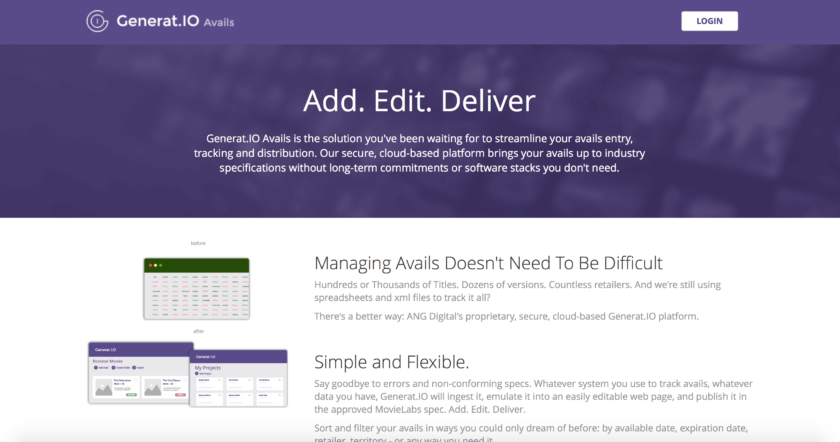Connections

ANG Digital: A New Approach to M&E Services
Story Highlights
Those in the M&E services sector should be familiar with Robert Gekchyan’s work over the years, from director of product management for Technicolor, to co-founding and serving as CTO of its dedicated second screen division MagicRuby, to leading technology for Deluxe’s New Media division.
And in the past year, he’s taken on a new endeavor: ANG Digital. Gekchyan founder and CEO of the solutions provider firm, spoke with the Media & Entertainment Services Alliance (MESA) about the origins of ANG, its unique approach to bringing solutions into the media services industry more quickly, and the benefits of its cloud-based Generat.IO platform.
MESA: How did ANG Digital first come about last year, what gap in the market were you looking to fill?
Gekchyan: I founded ANG Digital initially as a mechanism to bring solutions into the media services industry more quickly, specifically “middleware-as-a-service.” The idea was, media services workflows are evolving unevenly, where the automated steps can generate more and more throughput, but all that does is put a greater strain on the manual steps.
Now, you can address that bottleneck in two ways: either double up on manpower or engineer a solution that requires less “eyes on.” Most service providers are already operating at capacity and don’t have the luxury of diverting development resources to address anything beyond the biggest opportunities. So, in the end, we as an industry have chosen the manpower path, which is expensive.
Think of ANG Digital as the industry’s innovation shop. We’ve built some UX-friendly solutions to help media service providers and content owners alleviate the bottlenecks, without having to buy a whole software stack.
Our solutions utilize a back-end platform we call Generat.IO, built to accommodate whatever legacy, ad-hoc or off-the-shelf system you currently use, and simplify the authoring, approval and distribution process from there. You don’t own anything, you don’t have to hire or train anyone, you don’t have to learn anything you don’t already know. You can go back to your day job of making content. It’s an “on demand” model.
MESA: We haven’t heard of any other providers adopting this approach. Why is the ANG model only coming online now?
 Gekchyan: We have to remember that the legacy of our industry is the distribution of physical media on a massive scale. In fact, it was only two years ago that we finally generated more revenue from non-physical media than from physical media. We staffed accordingly, we accounted accordingly, we engineered accordingly.
Gekchyan: We have to remember that the legacy of our industry is the distribution of physical media on a massive scale. In fact, it was only two years ago that we finally generated more revenue from non-physical media than from physical media. We staffed accordingly, we accounted accordingly, we engineered accordingly.
Our market share leaders invested a lot of time and overhead in that way of thinking, to great success for many years, so you don’t abandon what has worked overnight. About five years ago Silicon Valley companies started approaching the industry with solutions, but they really didn’t understand our customers, so they never gained traction. It takes a company with industry experience (most of us have been in media services for 15 years or longer) and a “digital first” mentality to champion the innovation.
MESA: Helping content companies tackle avails is one of ANG’s top offerings. What makes the company’s cloud-based Generat.IO platform unique in helping navigate avails?
Gekchyan: In a word, it’s the platform’s simplicity. Ingest is simple: whatever form you currently keep your avails, whether it’s Excel, XML, or something of your own invention, Generat.IO will take what you have, populate it into the spec and show you the missing fields, the errors and the “fires.” Adding or editing data is simple, because we designed the user interface to be as intuitive as possible. Click, add, sort, cross-section, very intuitive. Even the business terms are simple: no long-term contracts, no on-prem equipment, no extra modules to buy.
MESA: From digital special features manifest creation and distribution to online rights management, the Generat.IO platform promises a host of content management solutions. Along with the removal of manual entry processes, speak to how important the visual-based aspects of Generat.IO is to helping companies manage content workflows.
Gekchyan: The visual-based tools allow marketing, operations and engineering to speak the same language, which saves on time and delivers a better overall product. I’ve always thought it was strange that we operate in a visual medium, yet so much of our authoring, review and approval is text or code-based.
Our clients don’t generally read code, but they do know visually when an asset is matched to the wrong scene, when a thumbnail is off or when an avail deal they worked on has the incorrect date, retailer or territory. And when a media services engineer is reviewing a manifest in XML code, he or she is actually translating that code into a visual map anyway, so we decided if visual was the common language anyway, the platform should emulate visually.
MESA: What’s next for ANG, what can we look forward to from the company?
Gekchyan: The new solutions are just the tip of the iceberg. We are taking the approach of examining the entire media services workflow and re-imagining how we would engineer it from the ground up using the same toolset that powers so-called “on-demand economy” platforms, like Uber.
The idea being, if we can simplify the workflow, removing the legacy costs without any reduction in service and content security, then we reduce the profitability breakeven point for content.
Studios, networks, independents, aggregators will be able to make their deeper catalog titles available to a greater audience because the cost to add a service — whether it’s digital special features, another language subtitled, or delivery to 100 new retailers — is no longer prohibitive.









